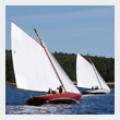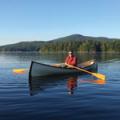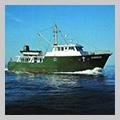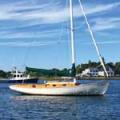Eliot Cutler: The Branding of Maine
“I am as certain as I can be that when we harness our creative energies—when all of us in business and government and academia in Maine start working together toward a set of shared goals—we can create an economic powerhouse in the State of Maine!”
—From a speech given by Eliot Cutler, former Maine gubernatorial candidate, at the Maine Boatbuilders Conference in Bath on December 6, 2012. The speech is posted below in its entirety.
***
Two years ago, after I lost my race for governor, I had to decide how I wanted to spend my time during the next chapter of my life . . . or at least the period between gubernatorial elections!
I decided that I wanted to devote significant effort to building bridges and economic relationships between Maine and China. Melanie and I had lived and worked in Beijing for three years, from 2006 to 2009, and I have believed for many years that Maine’s future economy will be largely driven by our development of export markets for branded Maine products.
With friends and partners, I formed two firms – Maine Seafood Ventures and MaineAsia – to do just that. I want to talk with you today about some of our experiences in branding and marketing Maine coastal products in China – and some of the public policy and business development lessons I have learned from them.
The sum of it all is this: I am as certain as I can be that when we harness our creative energies – when all of us in business and government and academia in Maine start working together toward a set of shared goals – we can create an economic powerhouse in the State of Maine!
The “rise of China” has been the economic story of the last decade and a half. China’s rapid growth has changed the competitive landscape for America, challenges many of our notions about America’s place in the world, and will shape our future in ways for which most of us are not yet well prepared. It is also the birth, or the rebirth, of the world’s greatest economy and biggest market.
This is the way the world economy looked in 2000. As had been the case since the late 19th century, the U.S. ranked way ahead of the rest of the world in both total and per capita GDP.
The ground has shifted under our feet in the years since 2000.
Professor Robert Fogel, the Nobel laureate economist at the University of Chicago, published a paper a few years ago in which he forecast the way the world will look in 2040, when he predicts China’s output will be three times the entire global output in 2000.
Fogel says that China’s economy in 2040 will be three times larger than that of the U.S., and the Chinese will approach 80% parity with America on even a per capita basis. At $85,000, China’s per capita GDP will be twice that of the EU15, which along with Japan will have shrunk by 2040 to near insignificance.
There obviously are a lot of variables at work in Fogel’s analysis, with plenty of room for subjective judgments, but the trends remain clear, persistent and incontestable.
China’s current five-year plan calls for the standard minimum wage to increase by 13% annually and for disposable income among residents of urban areas to increase by 7 % a year, all in real terms.
These numbers are huge in comparison to what we are getting used to here in America. Yet, what is happening is simply a reversion to the historical mean.
About 175 years ago, China closed itself off to the West; it was bypassed by the Industrial Revolution, and its share of global GDP fell to 4.5% in 1950 —one-tenth that of the U.S. But that 150-year period was an historical anomaly. In each of the previous 2000-3000 years, China accounted for 22-34% of the world’s economic output.
Today, there are 150 cities in China with more than 1 million people. There are dozens and dozens of cities with more people than the entire State of Maine.
I visited a city in China a few months ago that I had never heard of before, much less visited, with a population of eight million people.
Annual per capita retail sales in China have increased from about RMB 3,300 in 2000 to about RMB 15,000 today, an increase of 455%, or more than 40% per year.
How can Maine take advantage of this burgeoning new market? Let’s begin by taking a look a Maine’s most important economic cluster – tourism, the Maine coast and the creative economy. More than any other one of the United States, Maine has been defined by the sea. It was here that the ships were built for the China trade, and it is here, still today, where men and women build the ships that keep our Navy strong and the sail and power boats that set the bar for the rest of the world. Together with our forests and farms, our lakes and rivers and mountains, the Maine coast draws people here to visit and to live, it sparks our creative genius, it is a showcase for the skills and craft of Maine’s people . . . and it is a powerful competitive advantages. As we think about our Maine coast and try to solve the challenge of jobs and incomes that it presents, sometimes in unforgiving ways, we sometimes get confused . . . and confounded. We often make the mistake of thinking about this amazing resource – this ecosystem – in pieces independent of each other. What do we need to do to keep the big ships rolling down the ways at BIW? (Well, they don’t roll down the ways anymore, but I like the imagery!) How do we revive the ground fishery in the Gulf of Maine? How do we process more of our own lobsters for export to markets around the world? What is the best way to promote the unmatched quality of Maine-built boats?
Tourism – exporting the Maine experience – is Maine’s biggest export product. Where can we find the money – now estimated at roughly $3 - 4 billion – that it will cost to repair Maine’s roads and bridges so that we can double the number of tourists who visit Maine? In fact, all of these issues are elements – deeply interrelated to each other – of a single larger and deeply important question: How will we preserve Maine’s coastal communities? As a state, what are the policies we need to pursue and the investments that we need to make that will help Maine’s coastal towns and villages, both those with working waterfronts and those without, retain young people and survive against the gravitational pull of larger urban areas? If we fail to answer this question in a smart and strategic way, the consequences will be tragic. Without coastal communities, from Eastport to Kittery . . . o Maine’s largest industry – tourism – will be decimated; o Our Gulf of Maine fishery – the third largest by dollar value in America – will be left to fishermen and women from southern New England and the Canadian Maritimes; o Maine-built boats will become a lost art; and, o We will have ignored our own DNA, abandoned our competitive advantage, turned our backs on our past and put Maine’s future in peril. Yet, today we have no clear goals for preserving Maine’s coastal communities to which we are all committed. We’re not focused, we’re not thinking, and we sure as hell are not investing. We have no plan, no strategy, no shared idea of where we will be ten or twenty years from now. We have become fatally preoccupied in Maine with fighting over shares of a shrinking pie.
Let’s set a new course. Let’s put our extraordinary competitive advantages to work. Let’s build a Maine brand, market the hell out of our products and start making the pie bigger. Some might ask, why do we need to build an overarching, umbrella Maine brand? After all, lobster is already synonymous with Maine. And you boatbuilders have a great brand, “Maine Built Boats.” But you know what? Too many people around the world think that Maine lobster really comes from Canada or Boston, and no one in China has ever heard of Maine. Yes, we need to build and develop the Maine brand. The latent power of the Maine brand is extraordinary; there are a few states that are mythic, that hold Americans in thrall, and Maine is one of them. Yet, a powerful brand for our state is an opportunity that we have ignored for decades. Over the years we have moved from one slogan to another faster than our weather changes. Recently, and for a few years, our slogan was It Must Be Maine, a brand that some Business Week analysts said isn't well-known because “it is bland, dreary, and vague.” Now our slogan appears to be The Maine Thing. Really?? The Maine Thing? We don’t have everything wrong – there are, for instance, some wonderful new videos on the Maine tourism web site with Maine folks talking about why we all love to live here – but there is no evidence that we have invested the kind of time, effort, expertise and, yes, money that is necessary to develop a brand that is meaningful and that casts its net over all of the products and experiences for which we want Maine to be known. We need to develop a brand that motivates people to place a higher value on what we make and sell and on the experience of living and visiting here. If Virginia can be for lovers (as it has been for decades), if you and I can love New York, if pork can be the new white meat . . . then we ought to
be able to figure out how we want people to think about Maine, and develop a brand that will get them to think that way. For a state where so many jobs – now and in the future – are and will be found in this Maine Coast economic cluster – in tourism, in seafood production, in boatbuilding – there aren’t many more important investments that we can make in our future and in our kids’ futures than the development of a strong brand. At MaineAsia we believe – and I think we can demonstrate – that the predicate to selling Maine lobster or Maine-built boats in China is first to sell Maine, to build the umbrella Maine brand. With no disrespect toward the Governor’s recent visit to Shanghai and Hong Kong, you can’t sell Maine in China the way you can sell Maine in Maine. So we brought the Chinese here. On two separate visits, we hosted the Chairman, the President and the key buyers from COFCO, China’s largest food distributor. We took them to haul traps, so that they could see with their own eyes how sustainable and traceable Maine’s lobster fishery intends to be, visited blueberry barrens and mussel farms and worked with them on how to market Maine lobsters to Chinese consumers. The results have been spectacular: All over China, Maine lobsters are beginning to displace inferior product from Australia – whose lobsters are simply tasteless and have no claws – and Chinese consumers are learning about Maine. Chinese tourism to Maine is increasing, and more Chinese parents are sending their children to Maine schools and colleges. With support from Sabre and Back Cove, Hodgdon, Morris and Hinckley, we turned to Maine boatbuilding this past summer to see if we could apply some of those same lessons – marketing Maine in Maine – to achieve comparable results. Following a year of visits to boat shows in Xiamen, Qingdao, Shanghai and Hong Kong, my MaineAsia partner Tony Kieffer led a group of Chinese journalists and photographers on a five-day Maine coast journey in August, visiting boatyards and sampling their products; touring Acadia, mid-coast and Casco Bay. Annie Mahle cooked them dinner on the schooner J & E Riggin, and they watched the lobster boat races in Portland Harbor. Our visitors represented the two leading boating magazines in China – China Yachting and Boat Exclusive – and the number one lifestyle magazine for China’s rich and famous, The Hurun Report. What this single visit has achieved in exposure for Maine-built boats is stunning: So far, we have a 10-page, full color glossy spread in China Yachting that features a full page of editorial content on each of the participating boatyards and their products; and a similar, 6-page, full-color Glossy spread in Boating Exclusive. The Hurun Report issue covering Maine boats is on its way.
Here are some quotes from the magazines’ editorial content:
- “By the time [a Sabre] boat hits the end of the line, the quality supervisor hands over a boat of the ultimate quality in appearance and overall performance of the boat.”
- “Sailing a Morris yacht through waves chopped by the wind, you understand when Morris says that they understand what kind of boat makes a real good ship.”
- “By virtue of excellent building capability and meticulous service, Hinckley has won the worldwide reputation of being one of the best yachts in the world.”
- Both Boat Exclusive and China Yachting included in their coverage two full pages about Maine and the experience of visiting and living here. “As you can see,” one reporter wrote, “compared with Florida, Maine is an even more special place.”
Not bad.
MaineAsia, Maine boatbuilders, Maine lobster fishermen, Maine educators and the Maine tourism industry have a lot more work to do to build the Maine brand and sell Maine products – not only in China, but around the nation and the world.
Step One is working, as we have, in imaginative and strategic ways to build the Maine brand. Maine needs to claim a place on the map of the world; it’s just not enough for it to have a place in our hearts.
What are the next steps that you and we should take to sell more Maine boats in China? Here are some of the suggestions that Tony Kieffer and I would make to you:
- Together with tour operators and marketers, create trips for destination yachting, charters, and training in marine skills. Remember that we’re selling Maine, as well as Maine quality and Maine-built boats.
- Tie some of these vacation trips and charters to the visits that increasing numbers of Chinese parents and their children are making to Maine schools and colleges. These numbers are literally exploding.
- Do event-based marketing and visits around our own boat shows, regattas, cruise weeks and races.
- Attend and exhibit at the growing Chinese boat shows – together – and begin to think about design modifications that will make Maine boats even more attractive and compelling for Chinese and other Asian buyers.
Our ace in the hole should be the Maine brand and what it can come to represent: the innovation and skills that imbue our boat building, the uniqueness and accessibility of Maine's tourist and recreation experience, the quality of Maine food, the products of our natural resources and the rest of our creative economy.
No other place on earth has what we have here in Maine; no other place on earth can offer to visitors and consumers what Maine can; and no other state’s products could outsell those marked with a well-developed Maine brand.
What may be the most important lesson that we should learn from our decades of economic stagnation is this: Maine can compete, even in highly cost-sensitive industries and businesses, when niche advantages and capabilities favor us and when we focus our development efforts and strategies in areas where we have competitive advantages.
The Maine brand can be an enduring economic driver even in challenging economic times. Consumers around the world, whether buyers of high quality boats or tourists looking for new experiences, are willing to pay for the higher quality and unique characteristics of products and experiences associated and marked with brands that they know and respect. Maine can be just such a brand.
When we succeed at building that brand, we can turn the demographic tide in our favor. We can retain our own young people and draw others to Maine by offering them an opportunity to be innovative and creative in surroundings that no other state can match.
Now, we have recently become familiar with a different approach to improving our economic prospects, which is to focus aggressively – even exclusively and often myopically – on the expense side of the public ledger.
We can make all the budget cuts the most penurious among us might imagine, and we can achieve all of the bureaucratic reforms that the most efficient among us might prescribe, but we still will not adequately position ourselves to compete in the global economy.
We still will not effectively leverage our competitive advantages.
Our incomes still won’t be as high as they should be.
Our economy won’t be any larger; our prospects for future growth won’t be any stronger; and our children's opportunities here in Maine won't be any brighter.
Of course we need to eliminate waste and redundancy. But that has never been the standard for true leadership in either the public or the private sector.
In any enterprise, public or private, we can achieve great success, better jobs, higher incomes and economic growth only when we innovate, only when we have a vision and a plan for our future and a set of strategies to get us there to which most of us subscribe . . . and only when we position our strongest and most competitive industries like this one with a brand and a platform to reach worldwide markets and achieve greater profitability.
Our natural resources and our people can make Maine an economic powerhouse.
With new strength of will and a shared commitment we can finally make Maine both the best place in America to live and the best place in America to make a living.
Download a PDF of the speech here.
















